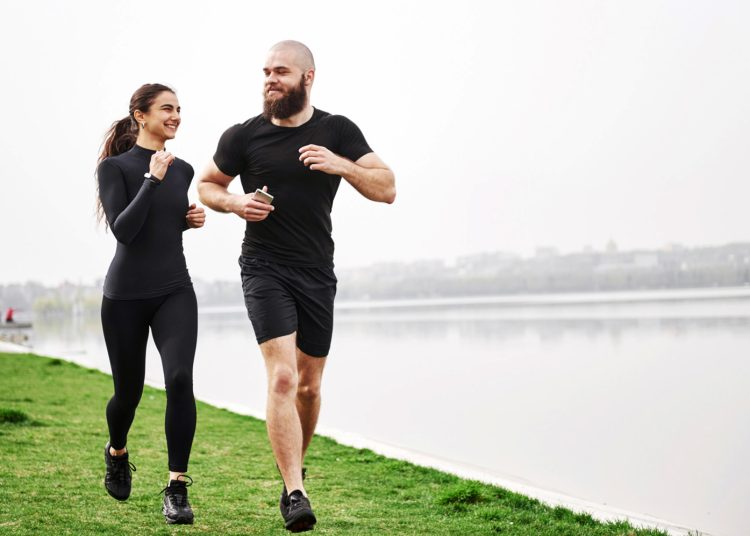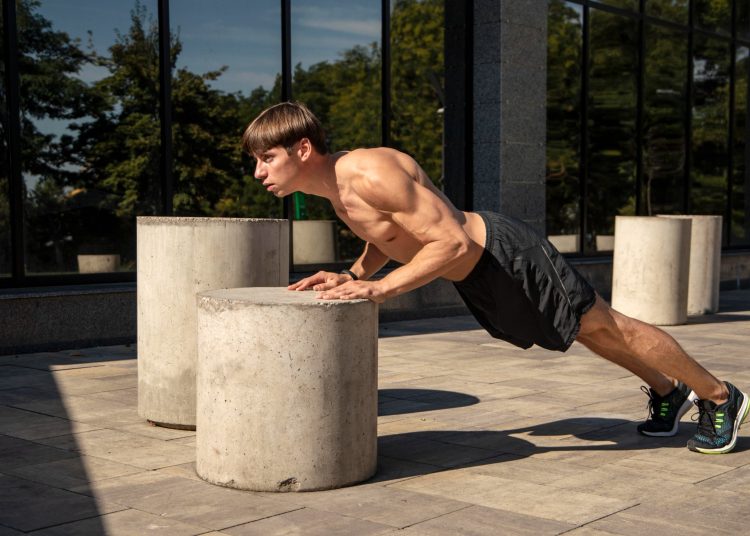High-Intensity Interval Training, known as HIIT for short, is a very popular workout. There are numerous ways to do HIIT, from bodyweight circuits to Tabatas to sprint intervals.
However, all types of HIIT share several characteristics:
- High or maximal exercise intensity
- Brief, incomplete rests
- Repeated bouts of work and rest
- Short overall workout time
- Increased energy expenditure compared to LISS cardio (1)
Another factor that links all types of HIIT is pain – lots of pain!
The intense bouts of exercise and short rests flood your muscles with lactic acid and drive your heart and breathing rate through the roof. These effects increase as your workout goes on, making the closing stages of any HIIT workout a test of mental and physical endurance.
As a veteran personal trainer with over 30 years of experience, I know how effective HIIT can be. I use it with many of my clients, especially those who enjoy tough-as-nails workouts or want to keep their workouts as short as possible.
However, while the appeal of HIIT is obvious, it’s not for everyone.
Older exercisers, beginners, and those with chronic medical conditions may find HIIT unsuitable, uncomfortable, and even dangerous. Plus, it’s hard to escape the fact that high-intensity interval training workouts hurt, which some exercisers find off-putting.
The good news is that you don’t have to kill yourself to get fit or burn fat, and while HIIT is popular and effective, it’s not the only way to get in shape.
In this article, I discuss a gentler workout that’s proven to boost fitness and lose fat – interval walking training.
What is Interval Walking Training?
Like all forms of interval training, interval walking (IWT) involves alternating periods of work with short rests. However, unlike HIIT, those work periods are not ultra-intense. Instead, you simply switch between brisk and slow walking.
For example, after a short warm-up, you could walk briskly for two minutes, walk slower for one minute, and repeat ten times for a total of 30 minutes.
While this might sound too easy to be beneficial, numerous Japanese studies strongly support the benefits of IWT and have found that its effects include (2, 3, 4):
- Weight loss
- Reduced fat mass
- Better cardiorespiratory health
- Increased leg strength and endurance
- Reduced blood pressure
- Lower blood glucose
- Improved circulation
- Increased aerobic capacity
- Improved metabolic health
These benefits are not unique to IWT, and you can experience similar effects from regular walking. However, interval walking training may provide better results in less time.
What Makes IWT Such a Great Workout?
Are you still unsure whether interval walking training deserves a place in your workout routine? Consider these advantages, and then decide!
Accessibility
Apart from some comfortable, supportive shoes, you don’t need any special equipment to do IWT. In fact, you can do it in your street clothes. This accessibility means there are fewer barriers to participation, making it easier to exercise consistently. Regardless of your chosen workout, consistency is the key to unlocking its benefits.
Low-Cost
Interval working training does not require a lot of money. You may even be able to do it without spending a dime. Lack of funds can make joining a gym or buying home workout equipment unappealing or impossible. With no costs to incur, IWT means there is one less reason not to exercise regularly.
Customizability
There are no hard and fast rules to IWT. Instead, you can alter this workout to suit your current fitness and workout goals. Modifiable factors include:
- Length of work periods
- Length of rest periods
- Walking speed
- Number of repeats
- Incline/terrain
- Frequency
For example, a beginner’s IWT workout plan could look something like this:
- Walk briskly (3mph) for one minute
- Walk slowly (2mph) for three minutes
- Repeat five times for a total of 20 minutes
- Do this workout three times a week on flat, smooth pavements
In contrast, a fitter, more experienced exerciser could do the following:
- Walk briskly (4mph) for three minutes
- Walk slowly (3mph) for three minutes
- Repeat six times for a total of 36 minutes
- Do this workout five times a week on undulating, unpaved trails
Low Risk of Injury
Walking is a very low-risk activity. That’s because it’s low impact, which minimizes joint stress. As such, walking injuries are very rare (5). This is very advantageous for older and overweight exercisers, who may find that traditional HIIT causes sore, painful joints.
Joint-friendliness is also an advantage for more experienced exercisers. Intense workouts can take a lot out of your body, leaving you prone to acute and chronic injuries. Replacing a few tough workouts per week with IWT will allow you to maintain your training while reducing joint stress.
Enjoyability
While some people find intense workouts satisfying and enjoyable, others do not. I’ve had personal training clients describe HIIT as “hellish” and tell me they don’t want to do it, even though the potential benefits are enormous.
IWT is the ideal alternative for those exercisers as the more sedate pace means less discomfort and a more enjoyable workout experience overall.
That’s not to say there aren’t downsides to IWT – there are. For example, it won’t get you as fit or burn as many calories as an HIIT workout. However, it’s arguably a better option if enjoyment is more important to you than maximizing fitness or fat-burning.
Social Interaction
Even if you do HIIT with a friend or training partner, you’ll probably be too out of breath to enjoy much social interaction. In contrast, the more relaxed pace of interval walking training means you’ll be able to talk more easily.
Social interaction can make fitness more enjoyable. It also helps pass the time by providing a distraction. Given the potential benefits of social support during exercise, this is a very valuable benefit.
Recovery Aid
You can’t train hard all the time. If you do, you run the risk of falling into overtraining. This is where your workouts outpace your ability to recover. Overtraining can lead to chronic fatigue, overuse injuries, lost motivation, and lost fitness. It can take many weeks or even months to get over overtraining.
Replacing 1-2 hard workouts with interval walking training could help you avoid overtraining while maintaining or increasing your fitness. Rather than being draining, IWT has the potential to be regenerative. Consider using IWT as an active recovery between more intense workouts or during deloads.
Outdoor Enjoyment
Outdoor or “green” workouts have many proven benefits, not least improved mental health. Taking your workout outside has been shown to lower stress and anxiety, boost your mood, and enhance cognition. In short, outdoor workouts are good for your body AND mind (6).
While there is nothing to stop you from doing interval walking training on a treadmill, I promise that you’ll get more benefits if you take your workout outdoors and enjoy some time in nature.
You don’t even have to head into the wilds; simply walking around your neighborhood will do you good.
FAQ’s
Do you have a question about IWT? No problem, because I’ve got the answers! But if you need more information, please drop me a line in the comments section below, and I’ll get back to you ASAP.
1. Will IWT help me lose weight?
Alternating between slow and brisk walking will burn more kilocalories than regular walking, contributing to increased fat burning and weight loss. However, the amount of energy you burn will depend on how far and fast you walk. That said, to maximize the weight loss power of IWT, you’ll need to combine it with a reduced kilocalorie diet, creating an energy deficit.
2. Is interval walking as effective as HIIT?
Full disclosure – IWT is less effective than HIIT for increasing fitness or burning fat. It’s simply not demanding enough to maximize these goals. However, unless you are a) a competitive athlete or b) desperate to lose weight as fast as possible, neither of these should concern you much.
It’s a common misconception that you must suffer to be fit, healthy, and lean. Interval walking training is the gentler way to get in shape!
3. Is interval walking training safe?
Interval walking is very safe and arguably safer than HIIT. However, if you have any health concerns, are very overweight, or have been sedentary for a long time, you should speak to your doctor before starting IWT or any other workout.
4. How often and for how long should I do interval walking?
Most studies into the effectiveness of IWT were conducted in Japan and involved three minutes of brisk walking alternated with three minutes at a slower pace repeated five times for a total of 30 minutes. Consequently, this gave rise to the most popular version of IWT – the Japanese 3 x 3 Interval Walking Workout.
Given the reported effectiveness of this protocol, most exercisers should aim for something similar. However, you should adjust work and rest time and training frequency to match your fitness.
For example, beginners may do better with shorter work periods, longer rests, and fewer repeats, e.g., two minutes brisk, four minutes slow, repeated four times. In contrast, more experienced exercises might choose to do six minutes fast, three minutes slow, repeated six times.
Experiment with these variables to design your perfect IWT workout.
5. Can I combine IWT with calisthenics?
This is a great idea! Throw in some push-ups, lunges, air squats, etc., to make interval walking even more effective. For example:
- Brisk walk for three minutes
- 15 push-ups
- Slow walk for two minutes
- Brisk walk for three minutes
- 15 lunges per leg
- Slow walk for two minutes
- Brisk walk for three minutes
- 10 bench dips push-ups
- Slow walk for two minutes
- Brisk walk for three minutes
- 20 air squats
- Slow walk for two minutes
Conclusion
You don’t have to kill yourself to get fit and lose weight, although you can if you want! Moderate exercise provides many of the benefits of more intense workouts but is often safer, easier on your joints, and better for beginner and older exercisers.
You don’t need to give up HIIT if you enjoy it, but it’s not compulsory, either. Try interval walking training to enjoy an easier path to fitness and health.
References:
Fitness Volt is committed to providing our readers with science-based information. We use only credible and peer-reviewed sources to support the information we share in our articles.
- Skelly LE, Andrews PC, Gillen JB, Martin BJ, Percival ME, Gibala MJ. High-intensity interval exercise induces 24-hour energy expenditure similar to traditional endurance exercise despite reduced duration. Appl Physiol Nutr Metab. 2014 Jul;39(7):845-8. doi: 10.1139/apnm-2013-0562. Epub 2014 Feb 6. PMID: 24773393.
- Kitajima K, Oiwa A, Miyakoshi T, Hosokawa M, Furihata M, Takahashi M, Masuki S, Nose H, Okubo Y, Sato A, Yamazaki M, Komatsu M. Interval walking training in type 2 diabetes: A pilot study to evaluate the applicability as exercise therapy. PLoS One. 2023 May 18;18(5):e0285762. doi: 10.1371/journal.pone.0285762. PMID: 37200321; PMCID: PMC10194951.
- Okamoto T, Hashimoto Y, Kobayashi R. Effects of interval walking training compared to normal walking training on cognitive and arterial function in older adults: a randomized controlled trial. Aging Clin Exp Res. 2019 Oct;31(10):1451-1459. doi: 10.1007/s40520-018-1093-8. Epub 2018 Dec 18. PMID: 30565191.
- Tsuda K, Hayashi E, Kamiya K, Kudo A, Kakihana H, Nakayama S, Ito Y, Saito M, Nukui Y, Hoshiga M, Tamaki J. Effects of interval-walking training on blood pressure in Japanese older adults. J Sports Med Phys Fitness. 2023 Mar;63(3):492-502. doi: 10.23736/S0022-4707.22.14263-5. Epub 2022 Oct 14. PMID: 36239289.
- Powell KE, Heath GW, Kresnow MJ, Sacks JJ, Branche CM. Injury rates from walking, gardening, weightlifting, outdoor bicycling, and aerobics. Med Sci Sports Exerc. 1998 Aug;30(8):1246-9. doi: 10.1097/00005768-199808000-00010. PMID: 9710864.
- Lahart I, Darcy P, Gidlow C, Calogiuri G. The Effects of Green Exercise on Physical and Mental Wellbeing. Int J Environ Res Public Health. 2019 Apr 15;16(8):1352. doi: 10.3390/ijerph16081352. PMID: 30991724; PMCID: PMC6518264.
منبع: https://fitnessvolt.com/interval-walking-training/


